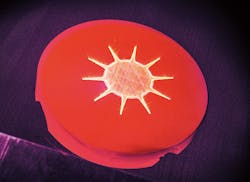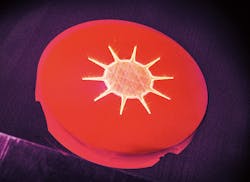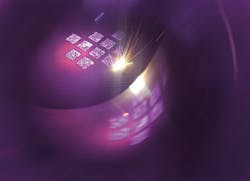FRANKFURT AND AACHEN, GERMANY – Additive manufacturing processes are booming, as evidenced by the rapid growth of the formnext trade fair. At formnext 2018, in cooperation with the Chair for Technology of Optical Systems (TOS) at RWTH Aachen University, the Fraunhofer Institute for Laser Technology (Fraunhofer ILT) will be showing a new process in which the component in the powder bed is heated with laser diodes. The method results in reduced distortion, generates taller parts, and enables use of new materials.
At formnext 2018, a team from Fraunhofer ILT and their colleagues from RWTH TOS will be presenting a new process. This process—laser powder-bed fusion (LPBF), also known as laser beam melting—can build parts with less thermally induced stress and less distortion than conventional process technology.
The internal stresses are caused by temperature gradients in the generated component. In the laser spot, temperatures above the melting point prevail, while the rest of the component cools rapidly. Depending on the geometry and material, this temperature gradient can even lead to cracks in the material. To avoid this, the component is usually heated from below via the substrate plate. However, that isn’t enough, especially with taller structures.
As part of the Digital Photonic Production (DPP) research campus, a funding initiative of the German Federal Ministry of Education and Research (BMBF), the experts from Fraunhofer ILT and the RWTH TOS Chair are working together with their partner Philips Photonics (Ulm, Germany) to develop solutions for this task. In the joint project DPP Nano, they have developed a setup in which the component is heated from above (FIGURE 1).
FIGURE 1. With up to 2.5 kW, the working plane is preheated independently of the overall height. (Copyright: Fraunhofer ILT, Aachen, Germany/Volker Lannert)
For this purpose, an array of six vertical-cavity surface-emitting laser (VCSEL) bars with 400 W each is installed in the process chamber. With infrared (IR) radiation at 808 nm, this array can heat the device from the top to several hundred degrees Celsius during the building process (FIGURE 2). The bars can be controlled individually so that sequences of different patterns are possible. The process is monitored with an IR camera.
FIGURE 2. Exposure at local preheating using a VCSEL is shown. (Copyright: Fraunhofer ILT, Aachen, Germany/Volker Lannert)
In another experiment, the engineers have constructed parts in Inconel 718 and demonstrated significantly reduced distortion. The component was heated up to 500°C.
The VCSEL heating reduces the thermal gradient, thus also the stresses, making it possible to produce taller parts. But even more interesting are the possibilities that arise for particularly difficult materials—soon, components made of titanium aluminides will be produced. For this, the component will be heated to approximately 900°C.
Such parts are commonly used, for example, in the hot gas section of turbochargers. In addition to turbomachinery, the process also opens up new prospects for other industrial sectors where thermally induced stresses in additive manufacturing processes have to be reduced.
For more information, please visit www.ilt.fraunhofer.de.


